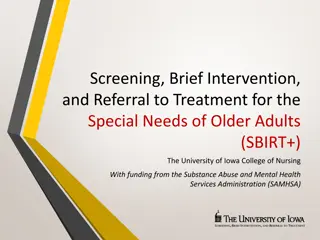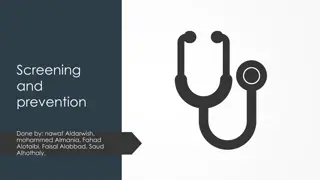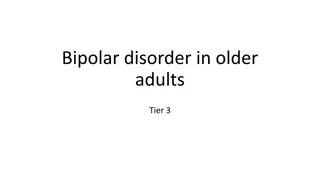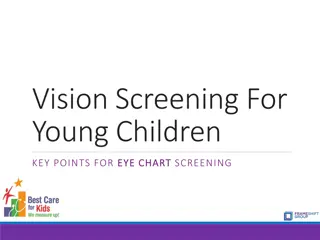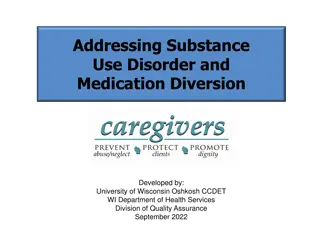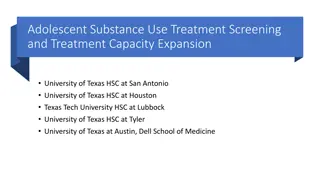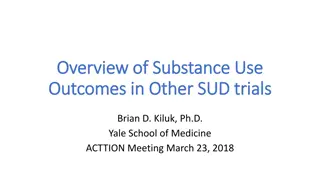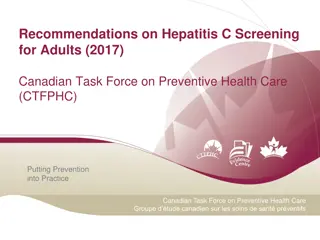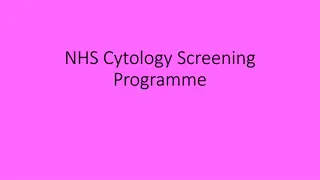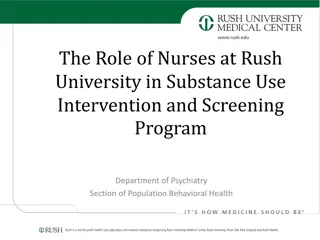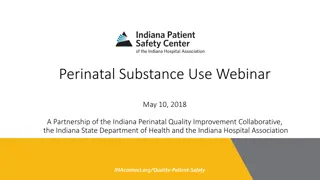Substance Use Screening, Risk Assessment, and Disorder Diagnosis Guidelines for Adults
This clinical guideline program aims to increase identification of unhealthy substance use among New York State residents and improve access to evidence-based interventions. It provides guidance on substance use screening, risk assessment, and promoting a harm reduction approach for substance use disorders. Screening tools help identify potentially unhealthy use, categorizing patients into low, moderate, or high-risk levels based on their substance use patterns. Clinicians are advised to screen for alcohol use and drug misuse in adults during initial visits and annually. The guideline emphasizes the importance of early detection and intervention for substance-related issues to prevent severe consequences.
Download Presentation

Please find below an Image/Link to download the presentation.
The content on the website is provided AS IS for your information and personal use only. It may not be sold, licensed, or shared on other websites without obtaining consent from the author. Download presentation by click this link. If you encounter any issues during the download, it is possible that the publisher has removed the file from their server.
E N D
Presentation Transcript
Substance Use Screening, Risk Assessment, and Use Disorder Diagnosis in Adults www.suguidelinesnys.org MAY 2024 NYSDOH AIDS Institute Clinical Guidelines Program
Purpose of This Guideline Purpose of This Guideline Increase the identification of unhealthy substance use among NYS residents and increase access to evidence-based interventions for appropriate patients. Unhealthy substance use refers to a spectrum of use that increases the risk of health consequences and ranges from hazardous or risky patterns of use to severe SUD. Increase the number of clinicians in NYS who perform substance use screening and risk assessment as an integral part of primary care. Provide clinicians with guidance on selecting validated substance use screening and risk assessment tools and on providing or referring for evidence-based interventions. Promote a harm reduction approach to the identification and treatment of substance use and SUDs, which involves practical strategies and ideas aimed at reducing the negative consequences associated with substance use. MAY 2024 NYSDOH AIDS Institute Clinical Guidelines Program www.suguidelinesnys.org
Unhealthy Substance Use Unhealthy Substance Use Unhealthy substance use refers to a spectrum of use that increases the risk of health consequences and ranges from hazardous or risky patterns of use to severe SUD. As defined here, unhealthy alcohol use is use that exceeds guideline- recommended levels; for illicitly manufactured drugs, any use is considered potentially unhealthy. For prescription medications with potential for misuse, any nonmedical use (use of prescribed medication at increased dose or frequency or for reasons other than prescribed) or use of medications that were not prescribed is considered unhealthy. Brief screening tools can identify potentially unhealthy use and can be followed by a risk assessment to determine the clinical significance and severity of use. MAY 2024 NYSDOH AIDS Institute Clinical Guidelines Program www.suguidelinesnys.org
Substance Use Levels of Risk Substance Use Levels of Risk Low risk: Patient is abstinent or uses substances in a way that is not currently associated with negative health consequences or other problems (e.g., alcohol consumption that does not exceed guideline-recommended levels or occasional low-dose cannabis use). Moderate risk: Patient is at risk of and may already be experiencing negative health consequences or other problems, such as elevated blood pressure related to alcohol use, atypical chest pain related to cocaine use, or family problems or poor work performance related to opioid use. High risk: Patient likely has an SUD, is likely experiencing substance-related health or other types of problems (e.g., alcohol use-related cirrhosis or consequences such as separation from family or loss of employment), and is engaging in continued or escalating use despite negative consequences. MAY 2024 NYSDOH AIDS Institute Clinical Guidelines Program www.suguidelinesnys.org
Recommendations: Recommendations: Screening Screening During the initial visit and once per year thereafter, primary care clinicians should screen for the following in adults 18 years old: Alcohol use, and when unhealthy use is identified, assess the level of risk to the patient. (A1) Tobacco use, and when it is identified, provide assessment and counseling. (A1) Other drug use (B3), and when unhealthy use is identified, assess the level of risk to the patient. (A3) Before screening for substance use, clinicians should explain the benefits and risks of screening to all patients, especially those who are pregnant or planning to conceive; the discussion should include state reporting requirements and the potential for involvement of child protective services. (A3) Clinicians should also repeat substance use screening to inform clinical care when: Prescribing medication(s) that have adverse interactions with alcohol or drugs. (A2) A patient has symptoms or medical conditions that could be caused or exacerbated by substance use. (A3) MAY 2024 NYSDOH AIDS Institute Clinical Guidelines Program www.suguidelinesnys.org
Figure 1: Substance Use Screening, Risk Figure 1: Substance Use Screening, Risk Assessment, Diagnosis, and Interventions Assessment, Diagnosis, and Interventions OCTOBER 2020 NYSDOH AIDS Institute Clinical Guidelines Program www.hivguidelines.org
Key Points: Key Points: Screening for Adult Primary Care Patients Screening for Adult Primary Care Patients Ask patients about substance use during the initial visit and follow-up visits because patterns of use may change over time. Annual screening may be most appropriate, and most validated alcohol and drug screening questionnaires ask about use in the past year. Inform patients that information about their substance use is protected by the same privacy laws that apply to all other information in their medical records. Urine toxicology, measures of blood alcohol level, and other laboratory tests should not be relied on for identifying unhealthy drug use. MAY 2024 NYSDOH AIDS Institute Clinical Guidelines Program www.suguidelinesnys.org
Implementing Substance Use Screening in Implementing Substance Use Screening in Primary Care Settings Primary Care Settings Who to screen: All adults seen by primary care providers should be screened for substance use. Some specific patient populations may have higher rates of unhealthy substance use, but no specific demographic characteristics reliably predict such use. How often to screen: Because substance use behavior changes over time, clinicians should repeat screening at regular intervals. However, evidence is lacking about the optimal frequency of screening. Annual screening may strike the best balance between the need for frequent repetition of screening and time and resource constraints and has been recommended by an expert panel. Who should perform screening: Most of the screening instruments discussed in Recommended Validated Tools for Use in Medical Settings to Screen for Alcohol and Drug Use in Adults can be administered verbally by trained staff or can be self-administered by patients on paper or electronically. Primary care practices must choose the format that is most appropriate for their clinical workflow and patient population. How to introduce substance use screening to patients: Explain the reasons for screening, the type of screening that will be performed, the potential benefits, and any potential harms. Make sure that patients understand how results will be interpreted and the likely response to screening results. Remind them of the privacy protections for the information being collected, including who will see the information; acknowledge the potential sensitivity of the information; and avoid judgmental or stigmatizing language. MAY 2024 NYSDOH AIDS Institute Clinical Guidelines Program www.suguidelinesnys.org
Recommendation: Screening Tools Recommendation: Screening Tools Clinicians should use standardized and validated questionnaires for substance use screening (see Recommended Validated Tools for Use in Medical Settings to Screen for Alcohol and Drug Use in Adults). (A3) Key Point: Whenever possible, it is best to have patients self- administer the screening and assessment questionnaires rather than having the clinician or staff ask the questions. In general, self- administered screening facilitates more accurate reporting of stigmatized behavior, such as substance use. MAY 2024 NYSDOH AIDS Institute Clinical Guidelines Program www.suguidelinesnys.org
Recommended Validated Tools for Use in Medical Recommended Validated Tools for Use in Medical Settings to Screen for Alcohol and Drug Use in Adults Settings to Screen for Alcohol and Drug Use in Adults No. of Items, Approximate Time Required to Complete, and Format Tool Substance(s) Included 3 items; 1 to 2 minutes Interviewer- or self-administered via electronic app or on paper AUDIT-C (Alcohol Use Disorders Identification Test Concise) Available in languages other than English Alcohol 1 item; 1 minute Interviewer- or self-administered via electronic app or on paper SISQ-Alc (Single-Item Screening Questions for Alcohol) Alcohol 1 item; 1 minute Self-administered on paper SIS-C (Single-Item Screen-Cannabis) Cannabis 1 item; 1 minute Interviewer- or self-administered via electronic app or on paper SISQ-Drug (Single-Item Screening Questions for Drug Use) Prescription drugs, other drugs 4 items; 2 minutes Interviewer- or self-administered via electronic app TAPS-1 (Tobacco, Alcohol, Prescription Medication, and Other Substance Use) Tobacco, alcohol, prescription drugs, other drugs 4 items; 2 minutes Interviewer- or self-administered via electronic app or on paper SUBS (Substance Use Brief Screen) Tobacco, alcohol, prescription drugs, other drugs MAY 2024 NYSDOH AIDS Institute Clinical Guidelines Program www.suguidelinesnys.org
Recommendations: Risk Assessment Recommendations: Risk Assessment Clinicians should assess the level of substance use risk in individuals who have a positive substance use screening result or a history of SUD or overdose. (A3) Clinicians should use standardized and validated tools to assess the level of risk associated with substance use (see Brief, Validated Risk Assessment Tools for Use in Medical Settings With Adults 18 Years Old). (A3) MAY 2024 NYSDOH AIDS Institute Clinical Guidelines Program www.suguidelinesnys.org
Brief, Validated Risk Assessment Tools for Use in Brief, Validated Risk Assessment Tools for Use in Medical Settings With Adult 18 Years Old Medical Settings With Adult 18 Years Old No. of Items, Approximate Time to Complete, and Format 10 to 71 items; 5 to 15 minutes, depending on no. of substances used Interviewer administered Tool Substance(s) Included ASSIST (Alcohol, Smoking, and Substance Involvement Screening Test) Available in languages other than English Tobacco, alcohol, prescription drugs, other drugs; identifies specific drug classes 4 to 25 items; 2 to 4 minutes, depending on no. of substances used Interviewer- or self-administered on computer/tablet 10 to 98 items; 5 to 15 minutes, depending on no. of substances used Self-administered on computer/tablet TAPS-2 (Tobacco, Alcohol, Prescription Medication, and Other Substance Use) Tobacco, alcohol, prescription drugs, other drugs; identifies specific drug classes ACASI-ASSIST (Audio Computer- Assisted Self-Interview ASSIST) Tobacco, alcohol, prescription drugs, other drugs; identifies specific drug classes MAY 2024 NYSDOH AIDS Institute Clinical Guidelines Program www.suguidelinesnys.org
Brief, Validated Risk Assessment Tools for Use in Medical Brief, Validated Risk Assessment Tools for Use in Medical Settings With Adult 18 Years Old, Settings With Adult 18 Years Old, continued continued No. of Items, Approximate Time to Complete, and Format 11 items; 5 minutes Self-administered on paper and documented in the electronic health record 10 items; 3 minutes Interviewer- or self-administered Tool Substance(s) Included Alcohol Symptom Checklist Alcohol AUDIT (Alcohol Use Disorders Identification Test) Available in languages other than English Alcohol 11 items; 5 minutes Interviewer- or self-administered on paper DUDIT (Drug Disorders Identification Test) Available in languages other than English All drugs; does not identify drug classes 10 items; 10 minutes or less Interviewer- or self-administered on paper DAST-10 (Drug Abuse Screening Test) Available in languages other than English All drugs; does not identify drug classes MAY 2024 NYSDOH AIDS Institute Clinical Guidelines Program www.suguidelinesnys.org
Recommendations: Recommendations: Patient Engagement and Interventions Patient Engagement and Interventions Clinicians should discern patients perceptions of their substance use and adjust interventions using techniques informed by motivational interviewing. (A3) For patients with low-risk substance use, clinicians should: Provide positive reinforcement for minimizing risk. (B3) Repeat screening annually. (A3) For patients with moderate-risk substance use, clinicians should further explore patients risk level (risk behaviors, pattern and quantity of use); if concern exists about high-risk use, perform or refer for SUD assessment with DSM-5-TR criteria. (A3) MAY 2024 NYSDOH AIDS Institute Clinical Guidelines Program www.suguidelinesnys.org
Recommendations: Recommendations: Patient Engagement and Interventions, Patient Engagement and Interventions, continued continued For patients with high-risk substance use, clinicians should perform or refer for SUD assessment with DSM-5-TR criteria. (A2 for alcohol, A3 for other drugs). For patients with moderate- or high-risk substance use not diagnosed as a use disorder, clinicians should: Offer brief advice on potential negative health consequences. (A3) Discuss harm reduction strategies, including reducing use. (A3) Provide or refer for a brief intervention informed by motivational interviewing. (A1 for alcohol, A3 for other drugs) Provide individualized follow-up. (A3) MAY 2024 NYSDOH AIDS Institute Clinical Guidelines Program www.suguidelinesnys.org
Recommendations: Recommendations: Diagnosis of Substance Use Disorder Diagnosis of Substance Use Disorder Clinicians should use the DSM-5-TR criteria to diagnose an SUD and determine its severity. (A3) If patients present with symptoms consistent with both an SUD and a mental health disorder, clinicians should assess for both types of disorder and refer for specialty behavioral healthcare when indicated. (A3) Clinicians should engage in shared decision-making with patients diagnosed with an SUD to develop an individualized treatment plan that includes pharmacologic and behavioral treatment as indicated and available. (A3) MAY 2024 NYSDOH AIDS Institute Clinical Guidelines Program www.suguidelinesnys.org
DSM DSM- -5 5- -TR Diagnostic Criteria for Diagnosing TR Diagnostic Criteria for Diagnosing and Classifying Substance Use Disorders and Classifying Substance Use Disorders Criteria Type Descriptions Consuming the substance in larger amounts and for a longer amount of time than intended. Persistent desire to cut down or regulate use. The individual may have unsuccessfully attempted to stop in the past. Spending a great deal of time obtaining, using, or recovering from the effects of substance use. Experiencing craving, a pressing desire to use the substance. Impaired control over substance use (DSM-5-TR criteria 1 to 4) Substance use impairs ability to fulfill major obligations at work, school, or home. Continued use of the substance despite it causing significant social or interpersonal problems. Reduction or discontinuation of recreational, social, or occupational activities because of substance use. Social impairment (DSM-5-TR criteria 5 to 7) Recurrent substance use in physically unsafe environments. Persistent substance use despite knowledge that it may cause or exacerbate physical or psychological problems. Risky use (DSM-5-TR criteria 8 and 9) Tolerance: Individual requires increasingly higher doses of the substance to achieve the desired effect, or the usual dose has a reduced effect; individuals may build tolerance to specific symptoms at different rates. Withdrawal: A collection of signs and symptoms that occurs when blood and tissue levels of the substance decrease. Individuals are likely to seek the substance to relieve symptoms. No documented withdrawal symptoms from hallucinogens, PCP, or inhalants. Note: Tolerance and withdrawal in the context of appropriate medical treatment do not count as criteria for an SUD. Pharmacologic (DSM-5-TR criteria 10 and 11) MAY 2024 NYSDOH AIDS Institute Clinical Guidelines Program www.suguidelinesnys.org
Need Help? Need Help? NYSDOH AIDS Institute Clinical Guidelines Program www.suguidelinesnys.org
Access the Guideline Access the Guideline www.suguidelinesnys.org> Substance Use Screening, Risk Assessment, and Use Disorder Diagnosis in Adults Also available: Printable pocket guide and PDF NYSDOH AIDS Institute Clinical Guidelines Program www.suguidelinesnys.org








